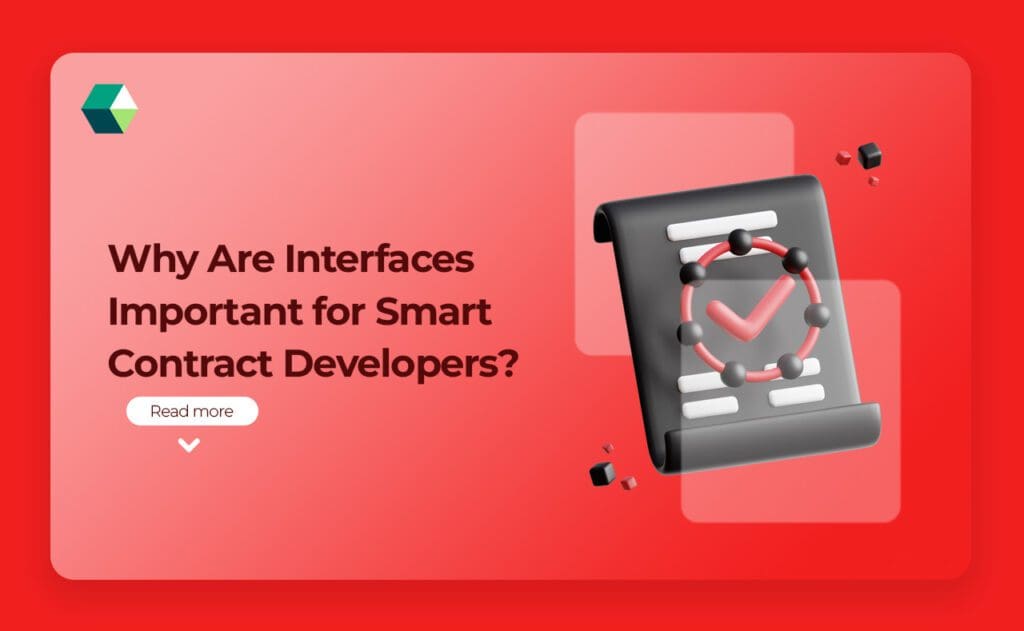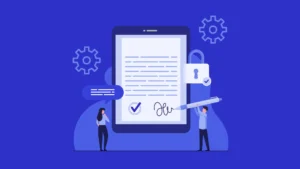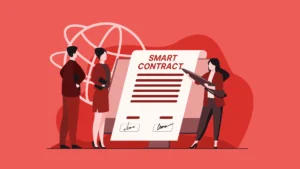
Smart contracts are a key part of blockchain technology, enabling secure and automated transactions. But for these contracts to work smoothly, developers need to use something called “interfaces.” Let’s explore what interfaces are, why they’re important, and how they help Smart Contract Developers.
What are Interfaces in Smart Contracts?
In Smart Contracts, Interfaces act like a set of guidelines or a contract’s menu that lists the functions a contract must include, but without detailing how those functions work. Think of it as a recipe that tells you what ingredients you need but doesn’t explain how to cook them. Interfaces allow different smart contracts to interact with each other smoothly by ensuring they follow the same set of rules. This makes it easier for developers to build, understand, and integrate smart contracts, leading to fewer mistakes and more efficient development.
Smart Contract Development Helps Your Startup Succeed
Smart Contract Development can be a game-changer for your startup, helping it succeed in several key ways. Smart contracts are self-executing agreements with terms written into code, which automatically carry out transactions when certain conditions are met. This means you can automate processes like payments, agreements, and data sharing, saving time and reducing the need for middlemen.
For your startup, this translates into faster, more efficient operations and lower costs. Plus, smart contracts enhance security and transparency, as all transactions are recorded on the blockchain and can’t be altered once confirmed. This builds trust with your customers and partners, making your startup more reliable and attractive. By leveraging smart contracts, you can streamline your operations, cut costs, and establish a strong foundation for growth.
Why Are Interfaces Essential for Smart Contract Developers?
Interfaces are essential for Smart Contract Developers because they provide a clear and consistent way for different contracts to interact with each other. An interface in smart contracts defines a set of functions that a contract must have, but it doesn’t include details on how these functions work. This is like having a common set of instructions that everyone can follow, ensuring that different contracts can “speak the same language” and work together smoothly.
For developers, using interfaces simplifies the process of building and integrating smart contracts. It allows them to design contracts that can easily interact with other contracts or systems, even if those contracts have different internal workings. This makes the development process more efficient and helps prevent errors by providing a clear structure to follow.
In addition, interfaces make it easier to update or change a contract’s implementation without disrupting the overall system. As long as the new implementation follows the same interface, it can replace the old one seamlessly. This flexibility is crucial for maintaining and evolving smart contracts as projects grow and requirements change. Overall, interfaces are key to creating modular, reusable, and compatible smart contracts, making the development process smoother and more reliable.
How to Create a Smart Contract Interface?
Creating a Smart Contract Interface is a fundamental step in smart contract development that helps ensure clear communication and compatibility between different smart contracts. Here’s a more detailed guide on how to create an interface, including each step and its importance:
-
Define the Purpose of the Interface
Start by identifying the specific tasks and functions that your smart contract will need to perform. For instance, if you’re creating a token contract, you might need functions for transferring tokens, checking balances, or approving other contracts to spend tokens on behalf of a user. The purpose of the interface is to provide a clear outline of these required functions, which other contracts or applications can interact with.
-
Create the Interface File
In Solidity, the programming language commonly used for Ethereum smart contracts, you define an interface using the interface keyword. This interface is typically placed in a separate file to keep the code organized. An interface file includes only the function signatures—essentially a list of what functions a contract must implement—without any implementation details.
Here’s an example of an interface file named
IMyContract.sol:// SPDX-License-Identifier: MIT pragma solidity ^0.8.0; interface IMyContract { function transfer(address recipient, uint256 amount) external returns (bool); function balanceOf(address account) external view returns (uint256); }In this example,
IMyContractis the interface that defines two functions:transferandbalanceOf. Thetransferfunction is used to move tokens from one address to another, whilebalanceOfreturns the token balance of a specific address. -
Specify Function Signatures
Each function in the interface should include its name, input parameters, and return type. However, the implementation logic—how these functions work internally—is not part of the interface. This separation ensures that any contract implementing this interface can be compatible as long as it adheres to the defined function signatures.
For example:
- Function Name: transfer
- Input Parameters: address recipient, uint256 amount
- Return Type: bool
-
Implement the Interface in a Smart Contract
After defining the interface, you need to implement it in a smart contract. This is where you write the actual code that performs the operations described in the interface. The Smart Contract must use the
overridekeyword to indicate that it is providing the implementation for the functions defined in the interface.Here’s how you can implement the interface in a smart contract:
// SPDX-License-Identifier: MIT pragma solidity ^0.8.0; import "./IMyContract.sol"; // Import the interface contract MyContract is IMyContract { mapping(address => uint256) private _balances; function transfer(address recipient, uint256 amount) external override returns (bool) { // Implementation code for transferring tokens require(_balances[msg.sender] >= amount, "Insufficient balance"); _balances[msg.sender] -= amount; _balances[recipient] += amount; return true; } function balanceOf(address account) external view override returns (uint256) { // Implementation code for checking balance return _balances[account]; } }In this example,
MyContractimplement theIMyContractinterface. Thetransferfunction moves tokens from the sender to the recipient, and thebalanceOffunction returns the balance of the specified address. Theoverridekeyword is used to confirm that these functions fulfill the interface’s requirements. -
Test the Implementation
Once you’ve implemented the interface, it’s crucial to test your smart contract thoroughly. Testing involves writing test cases to verify that all functions work as expected and that the contract interacts correctly with other contracts or systems. This step helps catch any bugs or issues before the contract is deployed on the blockchain.
-
Deploy and Use
After successful testing, deploy your smart contract on the blockchain. Other smart contracts or decentralized applications (DApps) that need to interact with your contract will use the interface to ensure they are calling the correct functions with the right parameters. The interface serves as a contract with the outside world, providing a standardized way to interact with your smart contract.
Interfaces Support Different Smart Contract Versions
Interfaces play a crucial role in supporting different versions of smart contracts by providing a standardized way for contracts to interact, regardless of their underlying implementation. When smart contracts evolve—whether through upgrades, new features, or bug fixes—interfaces ensure that older and newer versions can still work together seamlessly.
Think of it like a phone charger that fits various phone models. No matter how the phone’s internal components change, as long as the charger has the same plug, it will work. Similarly, if a smart contract, such as Liquidity Pool Contracts , follows a specific interface, it guarantees that any contract adhering to that interface can interact with it, even if the contract’s code changes. This compatibility is vital for maintaining and upgrading contracts without disrupting existing systems. By using interfaces, developers can introduce new features or improvements to their smart contracts, including Liquidity Pool Contracts, while keeping them interoperable with other contracts and applications that rely on the original interface.
Smart Contract Development Services for Your Business
Smart contract development services can greatly benefit your business by providing tailored solutions for automating and securing transactions. These services involve creating digital contracts that automatically execute and enforce terms when certain conditions are met, which can streamline various business processes. For instance, they can automate payments, manage agreements, and handle complex operations without manual intervention.
By using Smart Contract Development Services , your business can save time and reduce errors, as these contracts work on a blockchain that ensures transparency and security. You don’t need to worry about manual processing or potential fraud because the contract’s code handles everything automatically and is recorded on a secure ledger.
Additionally, Smart Contract Developers can customize solutions to fit your specific needs, whether it’s for managing supply chains, handling customer transactions, or creating decentralized applications. This customization helps you integrate smart contracts seamlessly into your existing systems and business models, enhancing efficiency and trust. Overall, smart contract development services can help your business operate more smoothly, securely, and efficiently.
Key Parts of a Smart Contract Interface
A smart contract interface serves as a blueprint for how different smart contracts and decentralized applications (DApps) interact with each other on the blockchain. It defines a standardized set of functions and behaviors that a smart contract must adhere to, without detailing the internal workings of those functions. Here’s a more detailed breakdown of the key parts of a smart contract interface:
-
Function Signatures
Function signatures consist of the function name, the types of parameters it accepts, and the return type. This part of the interface specifies what functions are available for interaction and what data is required or returned.
Example:
function transfer(address recipient, uint256 amount) external returns (bool);By defining these signatures, the interface ensures that other contracts or applications know exactly what functions are available and how to use them. This clarity is crucial for interoperability, allowing different smart contracts to work together seamlessly.
-
Visibility and Modifiers
Visibility modifiers (public, external, internal, private) determine who can access and call the functions. Additionally, function modifiers like view, pure, and payable define how functions interact with the contract’s state.
Example:
function balanceOf(address account) external view returns (uint256);Visibility and modifiers control how functions are accessed and how they impact the contract’s state.
externalfunctions are callable from outside the contract, whileinternalandprivatefunctions are restricted to within the contract.viewfunctions do not alter the state,purefunctions neither read nor modify the state, andpayablefunctions can accept Ether. This setup helps in designing secure and efficient contracts by clearly defining function access and behavior. -
Event Definitions
Events are used to log significant actions or state changes within the contract. They emit data to the blockchain that can be monitored by external applications.
Example:
event Transfer(address indexed from, address indexed to, uint256 value);Events provide a way to track and record actions, such as transfers or contract changes. External systems, such as user interfaces or analytics tools, can listen for these events to provide real-time updates or trigger actions based on contract activity. Events are vital for transparency and debugging, as they offer a record of what has happened in the contract.
-
Error Handling
While not always explicitly part of the interface, error-handling mechanisms can be defined within the functions. This includes specifying conditions under which errors occur or exceptions are thrown.
Example:
require(_balances[msg.sender] >= amount, "Insufficient balance");Error handling ensures that functions behave as expected and can handle exceptional or erroneous situations. This might include failing transactions under certain conditions or ensuring that inputs are valid. Proper error handling improves the reliability and robustness of smart contracts, making them safer to use.
-
Data Structures
Data structures, such as mappings, arrays, or structs, are used to store and manage data within the smart contract. While the interface itself does not include implementation details, it defines the types of data structures that will be interacted with.
Example:
mapping(address => uint256) public balances;Data structures are crucial for managing the internal state of a contract. They determine how data is stored and accessed, influencing the contract’s performance and functionality. By specifying data structures in the interface, developers can ensure that other contracts or applications interacting with the contract understand how data is organized and manipulated.
-
Function Types
Functions can be categorized based on their behavior, such as view (which only reads the state without modifying it), pure (which does not read or modify the state), or payable (which can accept Ether).
Example:
function balanceOf(address account) external view returns (uint256);Function types define how functions interact with the blockchain’s state and whether they can accept Ether. This categorization helps in understanding the function’s role and impact, facilitating better integration and use within the contract ecosystem.
Why Is Nadcab Labs a Top Choice for Smart Contract Interfaces?
Nadcab Labs stands out as a top choice for smart contract interfaces because they offer expertise and customized solutions that make complex blockchain projects easier to manage. They have a deep understanding of Smart Contract Development, ensuring that their interfaces are both secure and efficient. With Nadcab Labs, businesses benefit from their experience in designing clear and effective smart contract interfaces that facilitate smooth interactions between different contracts and applications. They focus on creating interfaces that are easy to use, reducing the chances of errors, and making it simpler for developers to build and integrate new functionalities. Additionally, their commitment to staying updated with the latest blockchain technologies ensures that the solutions they provide are cutting-edge and reliable.





